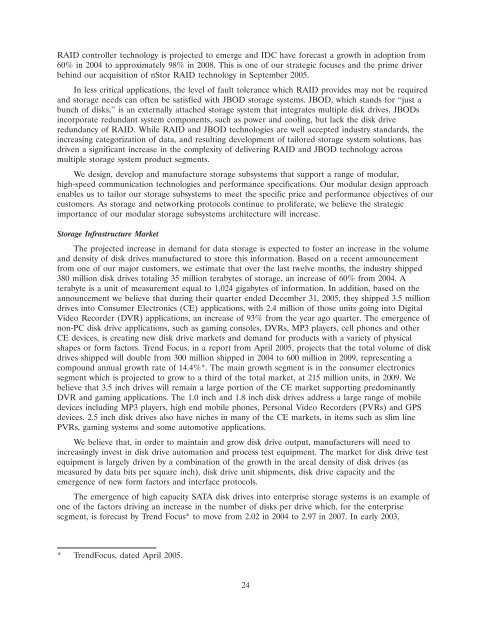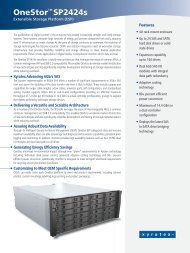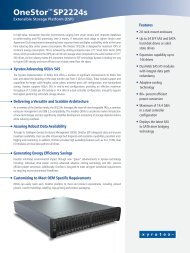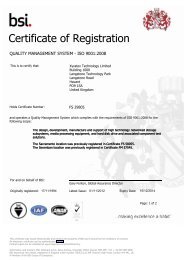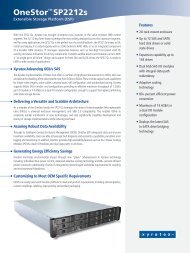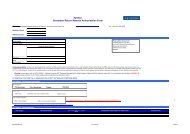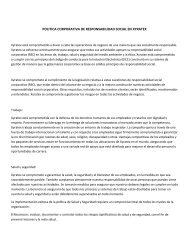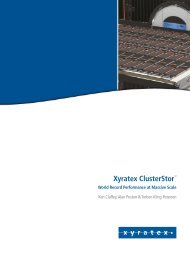Download Annual Report, 2.44 MB - Xyratex
Download Annual Report, 2.44 MB - Xyratex
Download Annual Report, 2.44 MB - Xyratex
- No tags were found...
Create successful ePaper yourself
Turn your PDF publications into a flip-book with our unique Google optimized e-Paper software.
RAID controller technology is projected to emerge and IDC have forecast a growth in adoption from60% in 2004 to approximately 98% in 2008. This is one of our strategic focuses and the prime driverbehind our acquisition of nStor RAID technology in September 2005.In less critical applications, the level of fault tolerance which RAID provides may not be requiredand storage needs can often be satisfied with JBOD storage systems. JBOD, which stands for ‘‘just abunch of disks,’’ is an externally attached storage system that integrates multiple disk drives. JBODsincorporate redundant system components, such as power and cooling, but lack the disk driveredundancy of RAID. While RAID and JBOD technologies are well accepted industry standards, theincreasing categorization of data, and resulting development of tailored storage system solutions, hasdriven a significant increase in the complexity of delivering RAID and JBOD technology acrossmultiple storage system product segments.We design, develop and manufacture storage subsystems that support a range of modular,high-speed communication technologies and performance specifications. Our modular design approachenables us to tailor our storage subsystems to meet the specific price and performance objectives of ourcustomers. As storage and networking protocols continue to proliferate, we believe the strategicimportance of our modular storage subsystems architecture will increase.Storage Infrastructure MarketThe projected increase in demand for data storage is expected to foster an increase in the volumeand density of disk drives manufactured to store this information. Based on a recent announcementfrom one of our major customers, we estimate that over the last twelve months, the industry shipped380 million disk drives totaling 35 million terabytes of storage, an increase of 60% from 2004. Aterabyte is a unit of measurement equal to 1,024 gigabytes of information. In addition, based on theannouncement we believe that during their quarter ended December 31, 2005, they shipped 3.5 milliondrives into Consumer Electronics (CE) applications, with 2.4 million of those units going into DigitalVideo Recorder (DVR) applications, an increase of 93% from the year ago quarter. The emergence ofnon-PC disk drive applications, such as gaming consoles, DVRs, MP3 players, cell phones and otherCE devices, is creating new disk drive markets and demand for products with a variety of physicalshapes or form factors. Trend Focus, in a report from April 2005, projects that the total volume of diskdrives shipped will double from 300 million shipped in 2004 to 600 million in 2009, representing acompound annual growth rate of 14.4%*. The main growth segment is in the consumer electronicssegment which is projected to grow to a third of the total market, at 215 million units, in 2009. Webelieve that 3.5 inch drives will remain a large portion of the CE market supporting predominantlyDVR and gaming applications. The 1.0 inch and 1.8 inch disk drives address a large range of mobiledevices including MP3 players, high end mobile phones, Personal Video Recorders (PVRs) and GPSdevices. 2.5 inch disk drives also have niches in many of the CE markets, in items such as slim linePVRs, gaming systems and some automotive applications.We believe that, in order to maintain and grow disk drive output, manufacturers will need toincreasingly invest in disk drive automation and process test equipment. The market for disk drive testequipment is largely driven by a combination of the growth in the areal density of disk drives (asmeasured by data bits per square inch), disk drive unit shipments, disk drive capacity and theemergence of new form factors and interface protocols.The emergence of high capacity SATA disk drives into enterprise storage systems is an example ofone of the factors driving an increase in the number of disks per drive which, for the enterprisesegment, is forecast by Trend Focus* to move from 2.02 in 2004 to 2.97 in 2007. In early 2003,* TrendFocus, dated April 2005.24


